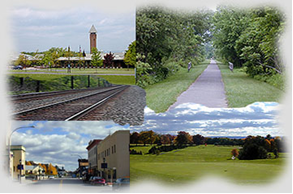Early Montgomery County History

General Richard Montgomery, born in Ireland December 2, 1736, became a citizen of New York, and, although a trained officer of the English Army, threw in his influence and service in the provincial affairs of America. On the opening of the Revolution he was made a general and ordered to march against Canada. He was successful at Chambly and Montreal, and in sole command of the attack against Quebec. But in his eagerness to be at the head of his men he was mortally wounded. Congress, in 1776, erected a monument to his memory, but the greatest memorial honor is that seventeen States have perpetuated his name by attaching it to as many counties, and almost as many cities.
Three years before the breaking out of the Revolution a great section of Albany County was set aside and named after the English Governor of the province, William Tryon. With the victorious ending of the war Tryon’s name was anathema to the lips of the patriots, and in 1784 honor was done to the dead hero of Quebec by changing the hated title to that of Montgomery.
Sir William Johnson had been the instigator of the movement to set up Tryon County. Sir William had settled in the region near what is now Johnstown, built himself a baronial mansion, acquired great acreages of land, attained an influence with the Indians which was valuable in the affairs of the province, and was a benefactor of the tenants and their neighbors who gathered around him. He supplied the land and money that went into the erection of the county buildings at Johnstown, the county seat. After the Revolution the Mohawk section and others began to have an accession of settlers, and the desire arose for smaller divisions of the State, and particularly Montgomery County. From 1789 to 1854 no fewer than thirty-five counties were carved from the original Montgomery, leaving it reduced, from being the larger part of New York State, to one of the smaller counties with an area of only 436 square miles.
Thirty-two pieces had been removed from Montgomery. The boundaries were getting narrowed and the county compact. But the growth of cities had been greater in those along the Mohawk than in the more northerly sections, and there were also more villages to the south. Complaint was made that it took too long and was too costly to make the long trip to Johnstown to attend to legal business. The result of this dissatisfaction was the removal of the county seat to Fonda. The residents of the north half of the county were incensed by this action and, in 1838, petitioned the Legislature to set their part off as a separate county, which was done under the title of Fulton. The departure of Fulton meant more than the loss of most of the other divisions, principally because with it went the last shreds of William Johnson’s work in the founding of the original county.
The county as left by this final division is bounded on the north by Fulton; on the east by Schenectady and Saratoga; on the south by Schenectady, Schoharie and Otsego; on the west by Herkimer. It is on both sides of the Mohawk, distant from Albany about forty miles. The land away from the river is generally elevated with many tributaries of the Mohawk flowing through the vales between the hills, the range between the highest and the lowest parts only amounting to some 440 feet. There are no usable minerals within the district, sand stone and lime rock being the only products quarried or mined. The effects of the glacial period are marked, resulting in a variety of soils. In general the county is well adapted to agriculture. The valleys are unusually rich, while the higher table land is freer from frost.
Dairying is the main agricultural industry, as much because of the ready markets to be found in the multiplying cities as the special fitness of the land. Vegetables are grown in many parts for the canning factories which are scattered throughout the Mohawk Valley. Fruit growing has, in the more recent years, become a specialty. Apples have from early times done well here, but the newer movement is in the planting of the small fruits. Manufacturing occupies the attention of the majority. The urban population far outnumbers the country; some of the richest factory concerns are represented in the county, and the variety of products is yearly increasing.
The settlement of this section of the State was the result of two very different streams of immigration. When Arent Van Corlear first visited the valley in 1661 he was immediately smitten with its charms, and straightway bought from the Indians large tracts of land. These purchases were confirmed by the English Governor, Dongan, in 1684, the Dutch having been displaced from power in New York. There was, however, no effort made to settle these tracts until early in the next century.
In 171O, as a result of one of the religious wars of Europe, certain refugees from the Lower Palatinate of Germany fled to England, and from there were sent to the York colony. The first of these groups came in 1707, although the greater numbers arrived in 171O (3,000), and were located on the Hudson. Dissatisfaction arose among them, and displeasure in the minds of those who felt they were their benefactors, with a result that the Palatines were sent off farther up the State by the English that they might be a barrier between the French and Indians and their precious selves. These Palatines did not prove much of a barrier in the war that soon followed, but they did scatter through much of the Montgomery region and exerted great influence in its development.

